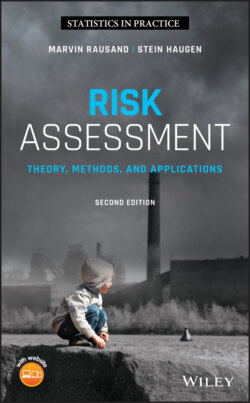Читать книгу Risk Assessment - Marvin Rausand - Страница 126
References
Оглавление1 ARAMIS (2004). Accidental Risk Assessment Methodology for Industries in the Context of the Seveso II Directive. Technical report EVSG1‐CT‐2001‐00036. Fifth Framework Programme of the European Community, Energy, Environment and Sustainable Development.
2 Aven, T. and Renn, O. (2009). On risk defined as an event where the outcome is uncertain. Journal of Risk Research 12 (1): 1–11.
3 Bayes, T. (1763). An essay towards solving a problem in the doctrine of chances. Philosophical Transactions of the Royal Society of London 53: 370–418.
4 Bernstein, P.L. (1998). Against the Gods: The Remarkable Story of Risk. Hoboken, NJ: Wiley.
5 Foster, H.D. (1993). Resilience theory and system evaluation. In: Verification and Validation of Complex Systems: Human Factors Issues (ed. J.A. Wise, V.D. Hopkin, and P. Stager), 35–60. Berlin: Springer.
6 Garrick, B.J. (2008). Quantifying and Controlling Catastrophic Risks. San Diego, CA: Academic Press.
7 Herrera, I.A., Håbrekke, S., Kråkenes, T. et al. (2010). Helicopter Safety Study (HSS‐3). Research report SINTEF A15753. Trondheim, Norway: SINTEF.
8 Hollnagel, E., Woods, D.D., and Leveson, N. (2006). Resilience Engineering: Concepts and Precepts. Aldershot: Ashgate.
9 IAEA (2002). Procedures for Conducting Probabilistic Safety Assessment for Non‐Reactor Nuclear Facilities. Technical report IAEA‐TECDOC‐1267. Vienna, Austria: International Atomic Energy Agency.
10 ISO 12100 (2010). Safety of machinery – general principles for design: risk assessment and risk reduction, International standard ISO 12100. Geneva: International Organization for Standardization.
11 ISO 31000 (2018). Risk management – guidelines, International standard. Geneva: International Organization for Standardization.
12 ISO Guide 73 (2009). Risk management – vocabulary, Guide. Geneva: International Organization for Standardization.
13 Jaynes, E.T. (2003). Probability Theory: The Logic of Science. Cambridge: Cambridge University Press.
14 Johansen, I.L. (2010). Foundations of Risk Assessment. ROSS report 201002. Trondheim, Norway: Norwegian University of Science and Technology.
15 Kaplan, S. (1997). The words of risk analysis. Risk Analysis 17: 407–417.
16 Kaplan, S. and Garrick, B.J. (1981). On the quantitative definition of risk. Risk Analysis 1 (1): 11–27.
17 Khan, F.I. and Abbasi, S.A. (2002). A criterion for developing credible accident scenarios for risk assessment. Journal of Loss Prevention in the Process Industries 15 (6): 467–475.
18 Kim, D., Kim, J., and Moon, I. (2006). Integration of accident scenario generation and multiobjective optimization for safety‐cost decision making in chemical processes. Journal of Loss Prevention in the Process Industries 19 (6): 705–713.
19 Klinke, A. and Renn, O. (2002). A new approach to risk evaluation and management: risk‐based, precaution‐based, and discourse‐based strategies. Risk Analysis 22 (6): 1071–1094.
20 Leveson, N. (2004). A new accident model for engineering safer systems. Safety Science 42 (4): 237–270.
21 Lindley, D.V. (2007). Understanding Uncertainty. Hoboken, NJ: Wiley.
22 Lupton, D. (1999). Risk. London: Routledge.
23 MIL‐STD‐882E (2012). Standard practice for system safety. Washington, DC: U.S. Department of Defense.
24 Perrow, C. (1984). Normal Accidents: Living with High‐Risk Technologies. New York: Basic Books.
25 Phimister, J.R., Bier, V.M., and Kunreuther, H.C. (eds.) (2004). Accident Precursor Analysis and Management: Reducing Technological Risk Through Diligence. Washington, DC: National Academies Press.
26 Rausand, M., Høyland, A., and Barros, A. (2020). System Reliability Theory: Models, Statistical Methods, and Applications, 3e. Hoboken, NJ: Wiley.
27 Reason, J. (1997). Managing the Risks of Organizational Accidents. Aldershot: Ashgate.
28 Rosa, E.A. (1998). Metatheoretical foundations for post‐normal risk. Journal of Risk Research 1 (1): 15–44.
29 Rosness, R., Guttormsen, G., Steiro, T. et al. (2004). Organizational Accidents and Resilient Organizations: Five Perspectives. STF38 A04403. Trondheim, Norway: SINTEF.
30 Royal Society (1992). Risk: Analysis, Perception and Management. London: Report of a Royal Society study group, Royal Society.
31 Suchman, E.A. (1961). A conceptual analysis of the accident problem. Social Problems 8 (3): 241–246.
32 Treasury Board (2001). Integrated Risk Management Framework. Catalogue Number BT22‐78/2001. Ottawa, Canada: Treasury Board of Canada. ISBN: 0‐622‐65673‐3.
33 U.S. DOE (1996). Process Safety Management for Highly Hazardous Chemicals. DOE‐HDBK‐1101‐86. Washington, DC: U.S. Department of Energy.
